If you pre-ordered the new RSN Techniques, Projects & Pure Inspiration book on Embroidered Boxes, then you probably already have it in hand.
Written by Heather Lewis under the auspices of the Royal School of Needlework and published by Search Press, the book came out last week. It is one of 20+ books on hand embroidery that Search Press is publishing in 2020, their 50th year in the publishing business.
I think this point pretty well establishes the fact that hand embroidery is alive and booming! Yay!
My book arrived last week, too. I pre-ordered it, and it arrived on its release date. If you haven’t purchased it – maybe it intrigues you, but you’re waiting for a few more details – then this review is for you.
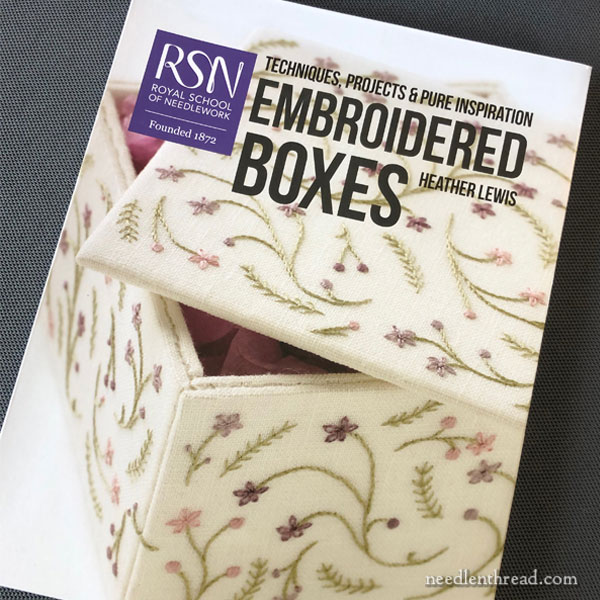
I didn’t have any problem pre-ordering this book even without seeing the insides. The cover sold me, despite all those years of being told not to judge books by their covers.
I love the delicate, simple design and the meticulous construction of the box on the cover. And, as strange as it sounds, there is one specific detail on the cover that caused me to fall in love with the book.
If you look at that cover, and you look closely at the box, there is one little stem from a floral element on the left side of the box that finishes on the other side butting up to it. It is perfectly aligned. Be still, my heart! I love that kind of precision. I rarely achieve it, but I do admire it when I see it!
So, yes, I was predisposed to love the book before it ever arrived. And this can be a good thing, but it can also be a bad thing. A predisposition to like something without knowing it can lead to disappointment. Or it can lead to a skewed positivity that might keep one’s view from being objective.
Now that the book has had time to settle on me, here’s my take!
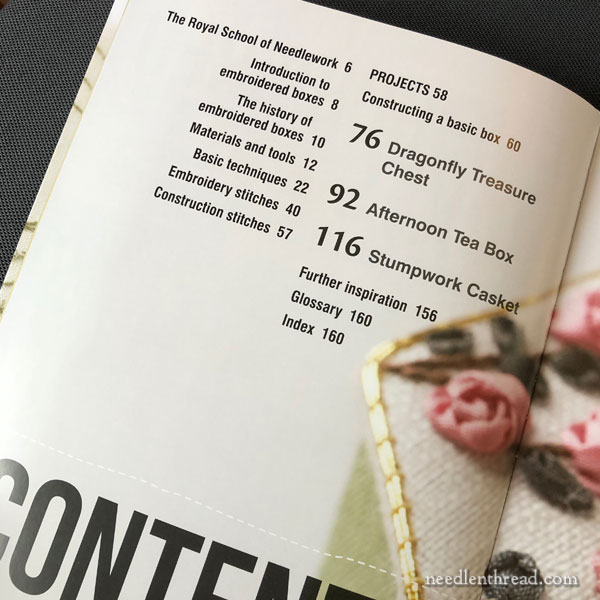
I’ve been anticipating this particular book since I first heard it was coming.
Box-making has always enchanted me, and embroidered boxes – while a bit time consuming to construct – are a fascinating way to finish a piece of embroidery into something that can be useful, beautiful, and treasured.
The book does not disappoint. It covers everything you need to know to construct an embroidered box, from the planning to the embroidery to the construction.
And it includes three (four, actually) workable projects that range from simple (a basic box) to rather complex (a stumpwork casket with doors and drawers).
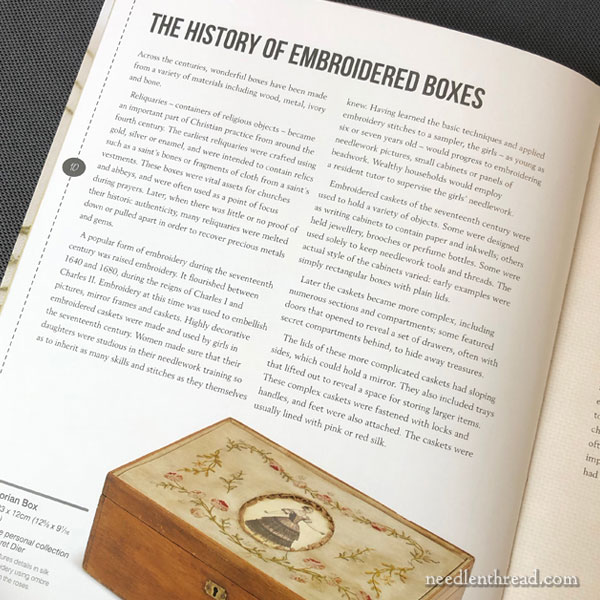
After an introduction to the RSN (Royal School of Needlework), we find a short, readable history of embroidered boxes – which have been around for a long time!
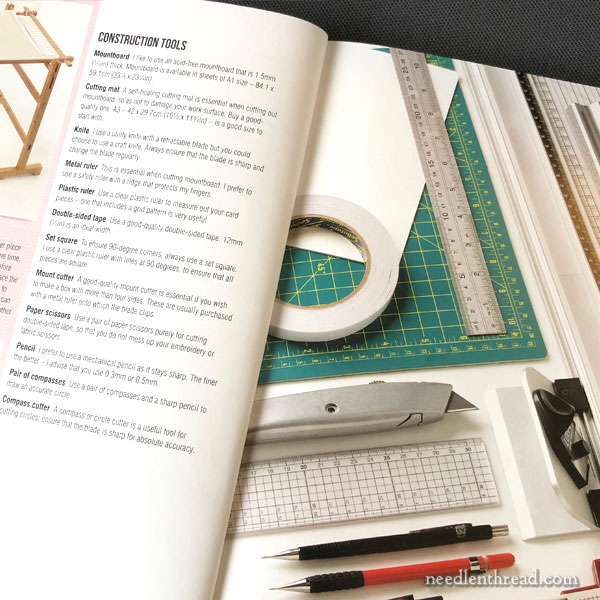
From there, we move into materials used in making embroidered boxes. There are a good ten or so pages dedicated to the materials involved.
Besides the requirements for an embroidery project, you also have to consider the construction materials and tools that are necessary for box-making.
The boxes in this book differ from the full-fledged, engineered wooden box built by a carpenter and mounted with embroidery. The boxes herein are made from mat board that’s been covered with fabric, and in that regard, making them is an accessible undertaking for practically anyone interested in doing so.
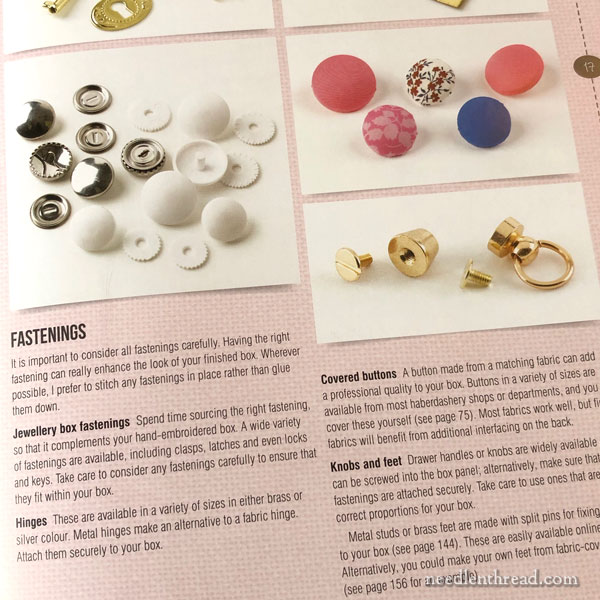
Depending on the type of box you want to make, there are also fasteners, hinges, locks, feet, and other hardware to consider.
When it comes to the embroidery supplies, the other requirements are pretty standard: fabric, threads, ribbons, embellishments, hoop or frame, scissors, and all the normal expectations of a project. Lining and interior fabrics are part of the equation, too.
All the supplies are covered very thoroughly. The only hiccup might be in the occasional name of things. For example, “mountboard” is essentially mat board in the US.
If you want, you can also substitute heavier board, like book-binder’s board and the like, depending on what you plan to use your box for. But as far as this book goes, simple acid-free mat board is the favored construction ingredient.
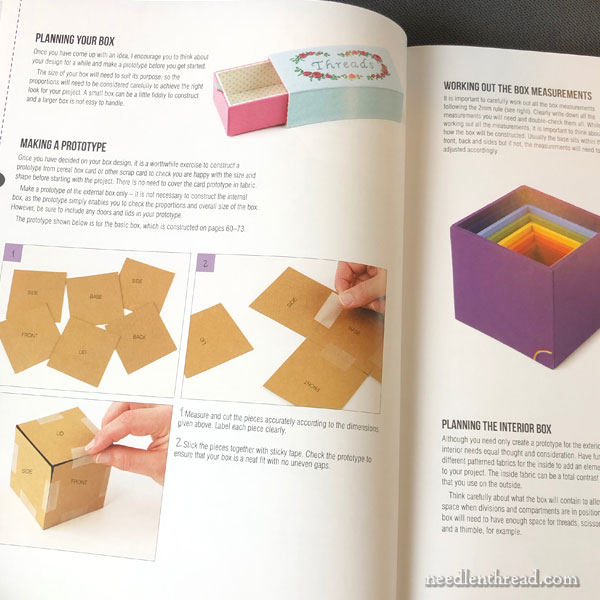
There’s an excellent section on planning out your box, building a prototype, considering the embellishment, and other preliminary planning steps.
With the advice in this section, you can pretty much plan any type of box you can conceive. How fun!
That said, there is a good reason why the instructional part of box-making begins with a very simple box. It’s never a bad idea to get some practice in the shallow end before jumping into the deep end!
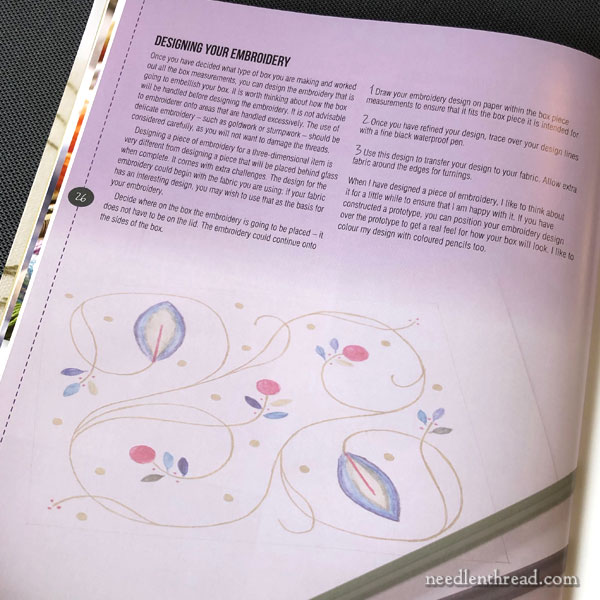
Of course, there’s a section on designing your embroidery for your box, and it is excellent, too. Here, you’ll be advised about considering stitches and techniques, and how they are affected by all the handling required in box-building.
You can approach box making with embroidery two different ways: you can design a box, and then design your embroidery to fit the box, or – because you’re the boss of your box! – you can take a piece of embroidery you’ve already done and design your box around it.
But Embroidered Boxes pretty much takes the approach of designing the box first and then designing embroidery to go on the box. You might have a concept in mind for the embroidery as you design your box, but once you’ve got the dimensions and areas planned out, you’ll design your embroidery to fit.
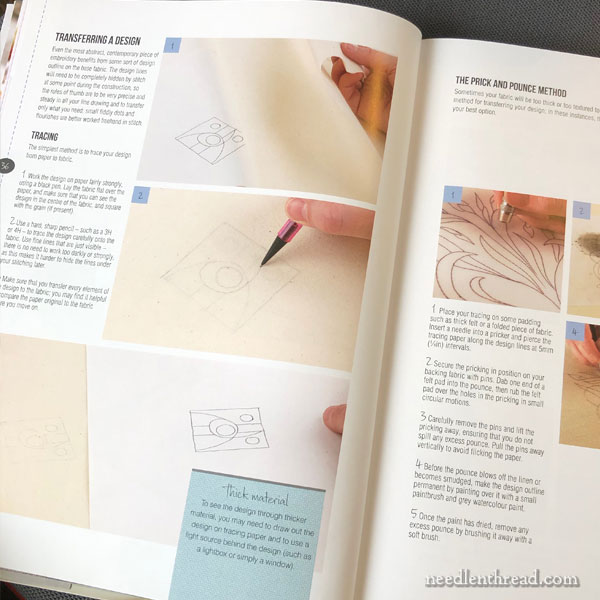
Then, we get into embroidery basics, from preparing a hoop or frame to transferring designs and stitching them.
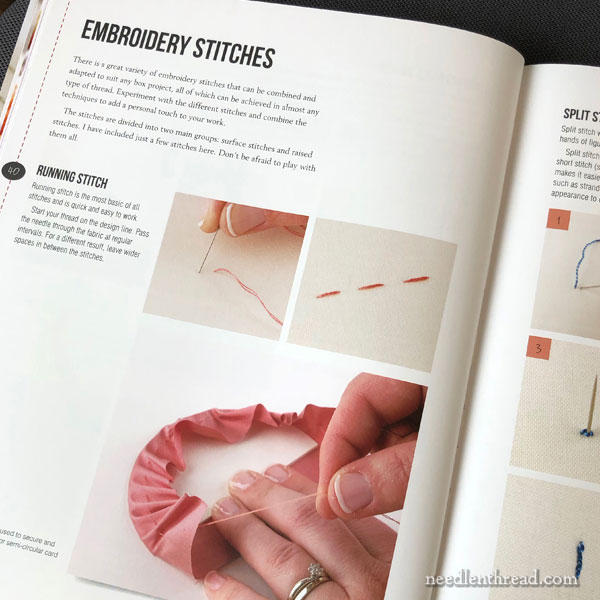
You’ll find a stitch dictionary covering all the stitches and techniques used on the projects in the book.
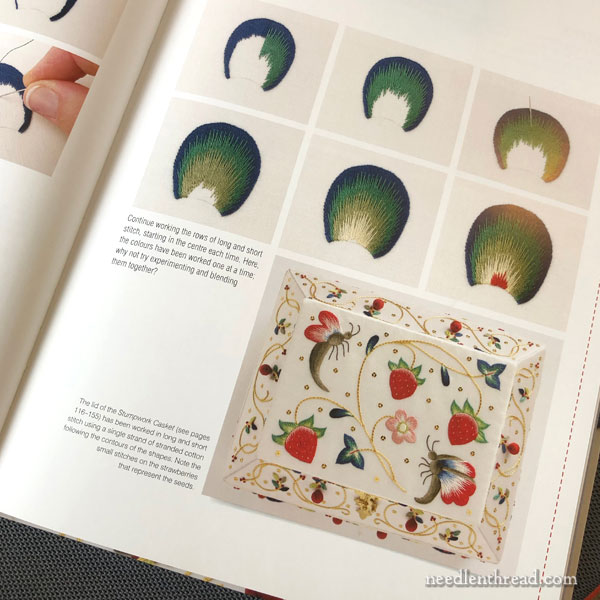
The stitch dictionary includes step-by-step photos to show the development of stitches and techniques.
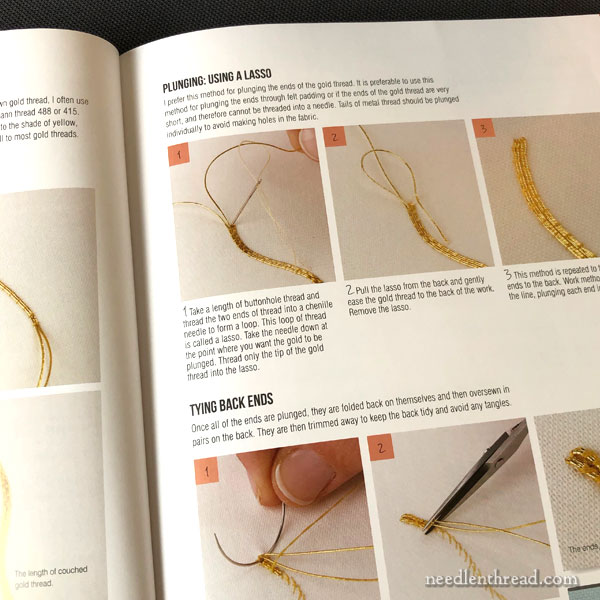
You’ll find some simple goldwork techniques covered, too.
And you’ll find the stitches that are used for actual construction covered in this area as well.
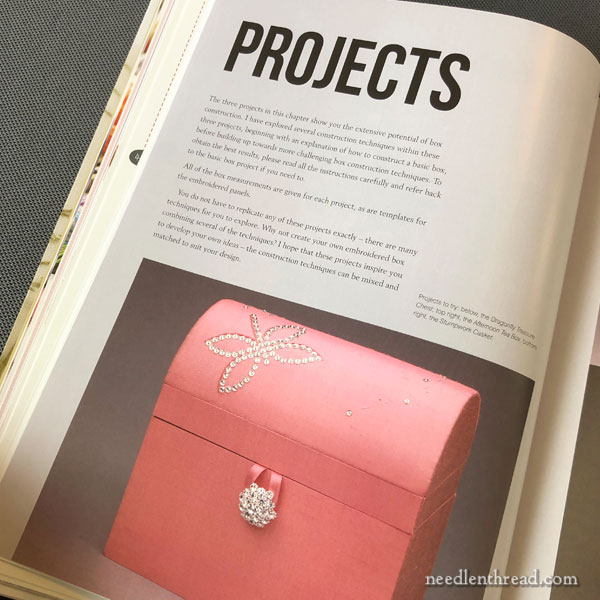
Then, we move on to the projects. There are three feature projects – this box with a domed lid…
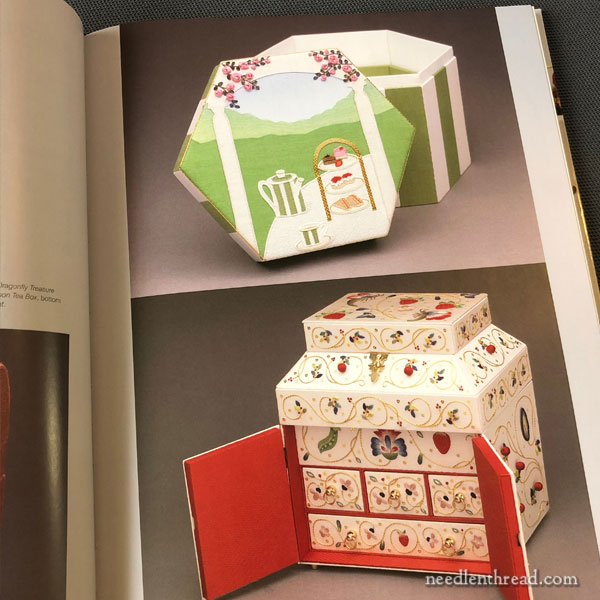
…a hexagon-shaped box with a drawer, and a stumpwork casket with doors and many drawers.
An Aside: The term “casket,” incidentally, simply refers here to a decorative box, which is what the word has meant for centuries. It has nothing to do with funereal rites or burial. I only bring this up because I’ve answered questions about the term “casket” too many times to count. If you want to know why this shift in meaning in America, you should probably read Evelyn Waugh’s satire, “The Loved One.”
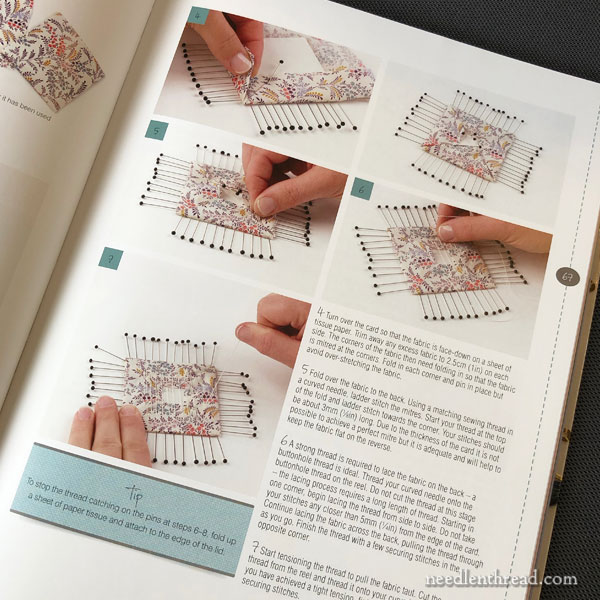
In the project section, you’ll find step-by-step instructions with photos showing how to construct a basic box.
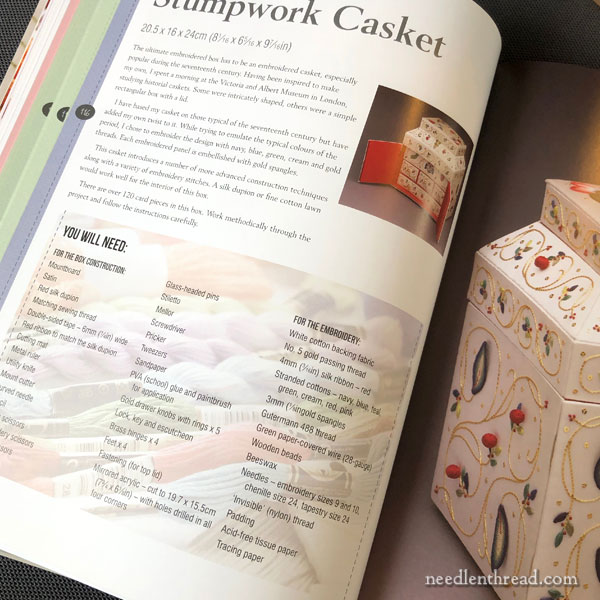
Then, for each of the three major projects, you’ll find a complete materials list with everything necessary to complete the box, all the dimensions for the pieces, with the amount of each that you need to prepare…
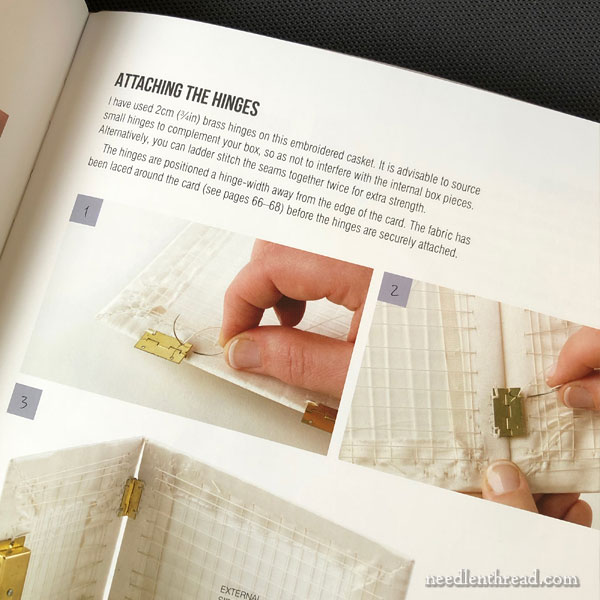
…plus step by step photos for finishing the project.
The instructions are really good! You won’t be left guessing!
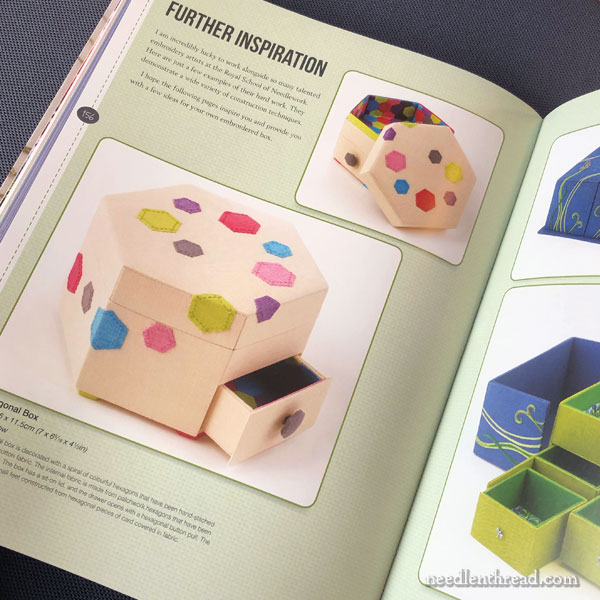
At the end of the book, there’s a short section on further inspiration, featuring photos of different boxes made by other embroiderers.
There’s also a glossary and an index.
In a Nutshell
Ahhhh. Yes! It is a wonderful book if you are interested in constructing your own embroidered boxes!
Because it is an RSN book, the methods are all RSN methods. This doesn’t mean there aren’t other ways to construct and finish boxes, but rather that, in a workshop setting, these are the construction methods they use to produce consistent results among their trained workers.
If you have a selection of different books on constructing boxes, you’ll discover other methods you can use that may save some time and still produce beautiful and perfectly acceptable results when constructing your own boxes.
This book, though, should be in your library! It’s beautiful, it’s clear, it’s instructive on all sorts of levels, and it is inspiring! It is one of those books that will help you take the technique beyond the book and make it your own.
Where to Find It
You can find Embroidered Boxes: Techniques, Projects & Pure Inspiration available through the following book sources:
In the US, it’s available on Amazon right now. You’ll find it listed on my Amazon Recommendations page, on my “Browse my Amazon Recommendations” list.
Worldwide with free shipping, it’s available here through Book Depository.
This article contains affiliate links to book sources, which means that any purchases you make through those links will result in a small commission for Needle ‘n Thread. Every little bit helps! Thank you!







I’ve never thought of making boxes and embroidering them but after this amazingly thorough and thoroughly interesting review of “Embroidered Boxes”, I’m intrigued and overwhelmed at the same time. This may be another book to add to my growing library. Thank you so much!
Morning Mary ~ my sister and I have always had a fascination with handmade boxes, some are treasure boxes and some have been made to hold a special gift, usually a Christmas ornament (hand made of course). Thank you for this review of what we can expect inside the covers. Like you, I was intrigued by the embroidery of the cover example and the way it continues around the box seamlessly, what a challenge for the designer. This book will be a wonderful addition to our libraries and I wonder who will get it first.
Happy stitching, Brenda.
This looks like one I will have to add to my collection. (And it’s Search Press so will be easy to find over here.) So far my many stitched boxes have been plastic canvas based, but I am always willing to experiment further…
A tip for materials to make boxes – to find mat board, visit a local framer. Often they will have a large pile of the cutouts from cutting mats to frame pictures. My framer gave me about ten pounds of mat board for free, all sizes and colors. Of course the mats will be different colors and textures, so you may have to use the backs or carefully select the colors. The outsides will be cut at an angle, but that can be helpful in making sharp corners.
I KNEW I shouldn’t have read your review!! Now I want that book (thanks for that Mary!). You are such an enabler!!!
Oh, I try, Mary Anne! 🙂 LOL! It’s a lovely book!
I, too, preordered this one. After reading Emma Broughton’s book last year I was excited to see how an RSN book would cover this material. As it turns out I like both books, but for different reasons.
Personally I find Emma Broughton’s instructions for the actual construction of boxes to be more helpful. I felt that she was much more thorough in explaining the various techniques used in covering card with fabric and in assembling pieces to make boxes. She also provided much more information about the various materials available.
On the other hand, that casket in Heather Lewis’s book is gorgeous and I want to make it someday! It’s much more exciting than anything in Emma Broughton’s book.
Thank you, Tim. I was wondering which book to choose. Maybe I should get both too. 🙂
I pre-ordered and was not disappointed. Fantastic book!
A lovely book , I have always wanted to do a stump work box and now I can . the instructions are relative easy to follow I would have likes a bit more information on how much material to buy and where to source all the fittings it has taken me hours of searching the web sites . I am stuck on finding the gold drawer knobs with rings can anybody help me please
Dear Mary
I do love RSN books I have the RSN Stumpwork and Bead Embroidery which I often use as reference on my embroidery shelf. I like the Casket very pretty and lots of draws which I like. It looks like a very good in-depth book on Box decorating. Great resource to have and learn from. Thank you for reviewing the RSN Techniques, Projects & Pure Inspiration book on Embroidered Boxes and for sharing your views on the book it looks and interesting read for embroiders.
Regards Anita Simmance
I recently bought this book and read through the instructions for making a basic box. They are truly very detailed and simply explained. Can’t wait to make a box of my own!!
Ohh Mary, Mary, Mary … you’ve convinced me! 🙂 I’ve had my eye on this book since you mentioned it previously but I would love to expand my box making skills once I’ve completed the Home Sweet Home project. Thank you for this comprehensive review … ‘Sold’ to the lady writing this comment! 🙂
I received the book yesterday. I wanted to start with the box on the cover but I don’t see the pattern or instructions for the box on the cover. The Stumpwork Casket is magnificent and there are instructions for that project. Am I missing something?
Liz
I love the book. However, disappointed that the pattern for the box on the cover is not in the book.